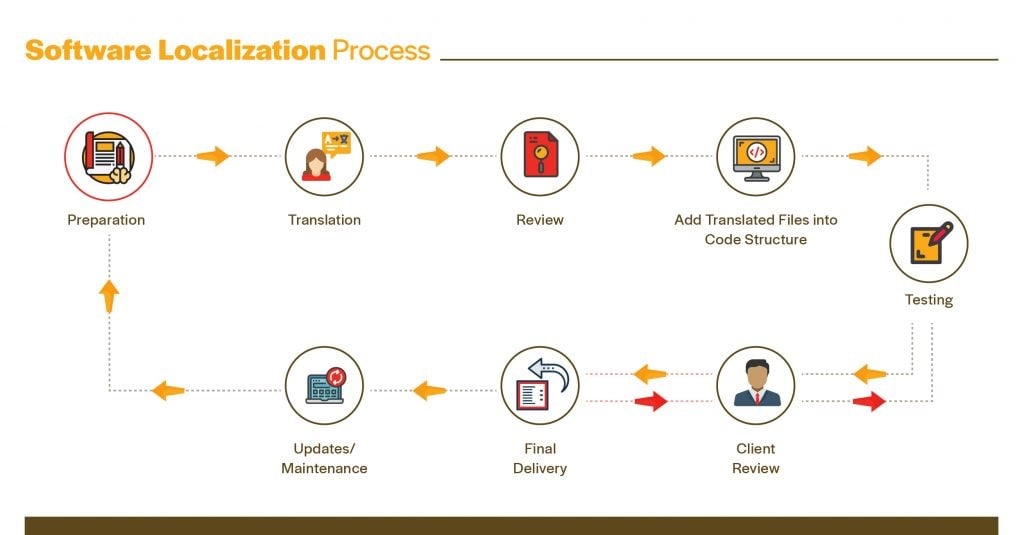The complete guide to global localization
What is global localization, why is it important, and what strategies can a company implement to achieve it? Let’s find out.

Global localization may sound like an oxymoron, but companies can’t overlook its value. If a website exists in only one language, say English, a business could miss up to 75% in revenue.
So, what is global localization, and what strategies can a company implement to achieve it?
Key takeaways:
-
Global localization is the business practice of adapting a brand’s message or product to the local language, culture and customs.
-
Benefits of implementing global localization techniques include gaining an edge over the competition, building customer loyalty and increasing revenue.
-
Five areas to consider are website, mobile app, content, software and platform localization.
What is global localization?
Global localization is the business practice of adapting a brand’s message or product to the local language, culture and customs. Localization is another step in providing a personalized customer experience. For global marketing teams, localized content needs to play a large part in the overall marketing strategy.
Let’s take McDonald’s as an example. Mainland United States residents are familiar with the Big Mac and Quarter Pounder offerings. When traveling to Puerto Rico, a U.S. territory, the website’s language switches to Spanish, and the breakfast section includes additional items made with “pan criollo,” a local type of bread. In Japan, McDonald’s adds Teriyaki Chicken and Roasted Soy Sauce Double Thick Beef burger options. And, in France, McDonald’s includes croissants, macarons and ristretto.
Why global localization strategy matters
-
You gain an edge over your competitors. If the competition isn’t working on global localization, you can get a strong foothold in your target market.
-
You build customer loyalty. When a company recognizes its customers’ needs, understands their culture and language, and adapts its products to fit them, buyers are more likely to make repeat purchases of its product or service.
-
You see an increase in revenue. A localized experience for your target audience means the potential for greater marketing penetration which leads to revenue growth.
4 ways to achieve global localization
Global localization in digital channels isn’t limited to native language translation. A business needs to comprehend the mindset of a culture and its nuances. Let’s explore four avenues where a company can mold its product to the local people.
1. Web localization
Determine the international markets where you’ll need to localize your product. Since global localization isn’t mere website translation, pick one locality to dip your toes in instead of targeting many places. Then, create a strategy for customizing your website.
Next, internationalize (abbreviated i18n due to the 18 letters between the “i” and the “n” in internationalization) your website. Internationalization means including a plugin that can consider future languages, including their distinct characters (e.g., Roman, Cyrillic, Hiragana) and direction (e.g., left to right, right to left, top to bottom). Furthermore, the code accounts for time zone, time format, numbering, currency, etc. If you perform internationalization efficiently from the start, you don’t need to redesign your process later.
Next, allow machine learning (ML) tools to do the first pass at translating your site. Afterward, have a human, native speaker proof it for quality assurance (more details in the content localization section). A translation management system is an excellent tool for this process.
Replace any images or videos with ones that would speak more to the local market. Perform another quality check and then publish.

2. Mobile app localization
Use the analytics data on your mobile app to determine the countries of residence of most of your loyal app users. Also, learn how your competitors are doing in different markets. Use these statistics and metrics when deciding which places to target for e-commerce localization.
Before starting, look at your app reviews left by the users of those countries. Do they describe any pain points? Are they making feature requests specific to their locality? Take into consideration these comments as you strategize e-commerce localization.
Determine what digital or hardware platform is popular with users of that market and focus efforts on it. Then, perform internationalization and localization on the app. For testing, try these scenarios:
-
Smoke test: One or a few employees familiar with the app (not the language) should test the localized app. These testers were not involved in the development process. The goal is to verify that the app still works as a user would expect.
-
Beta test: Release the app to a subset of native speakers, whether within the company or outside. Then, make needed changes based on their feedback.
Lastly, localize your app’s section in the App Store or Google Play.
3. Content localization
When localizing content like SEO blogs, videos and podcasts, it’s crucial to consider the locality of the audience. Here we dive a little deeper into the nuances of language.
For example, the English spoken and written in the U.S. differs from the English in the U.K. Where Americans join a line, the British join a queue. Where the British spell colour, Americans spell color. And we’re still talking about English.
Other languages have similar distinctions, so you need to write or record for that country. In Spanish, for instance, there are 11 ways to say straw, depending on the country. And a word that is inoffensive in one country is rude or distasteful in another.
Finally, expressions vary from place to place. Some places may not understand idioms like “running around like a chicken without its head” or “that’s just my two cents.” However, there may be other expressions to convey the same idea.
The rules for text apply to images too. A gesture that means warm and embracing in one culture can be insulting in another. Verify the pictures in your content are appealing to the local market.
4. Software localization
Regardless of the company’s software deployment process (e.g., Waterfall, Agile, Continuous), here are some tips for localization:
-
Each language should have its JSON or YAML file. Then, use placeholders in the primary code that reference the selected translation file.
-
Minimize hard coding.
-
Account for varying lengths of a word. For example, the width of the “Submit” button should adjust when translating the word to another language.
Reach global localization with Optimizely
Optimizely’s software solutions and team of experts can help you reach new markets and improve the global brand user experience. We’ll provide you with a data-driven decision-making strategy to streamline your global localization efforts, marketing campaign optimization and enhance your customers’ experience with your business.
Contact Optimizely to see how we can help you succeed in global localization!

